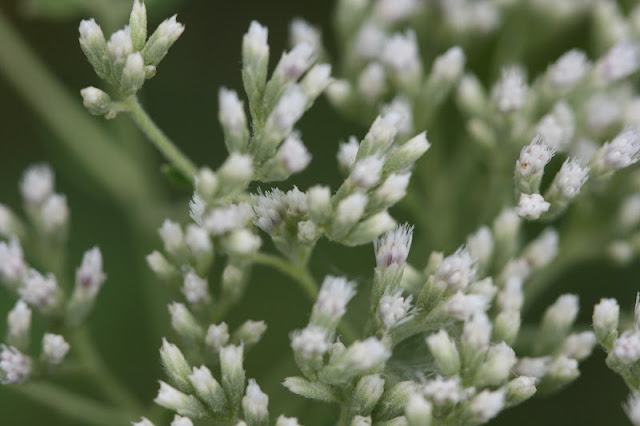 There are a great many thoroughworts in Florida (nearly 20 species and natural hybrids) and they can be somewhat difficult to distinguish from each other. Roundleaf thoroughwort (Eupatorium rotundifolium) is one of the most common. It can be found in a wide variety of mesic upland sites throughout Florida, except the extreme southeastern counties and in those locations it is often quite abundant. It also occurs throughout much of eastern North America, but has been extirpated or is very rare in most of the states in the extreme northeastern part of its range.
There are a great many thoroughworts in Florida (nearly 20 species and natural hybrids) and they can be somewhat difficult to distinguish from each other. Roundleaf thoroughwort (Eupatorium rotundifolium) is one of the most common. It can be found in a wide variety of mesic upland sites throughout Florida, except the extreme southeastern counties and in those locations it is often quite abundant. It also occurs throughout much of eastern North America, but has been extirpated or is very rare in most of the states in the extreme northeastern part of its range.
Roundleaf thoroughwort is a perennial that normally dies back to the ground in winter. It emerges in spring and forms a rosette of rounded basal leaves; each about 1 inch long and about 3/4 inch wide. The leaf margins are decidedly toothed and this is distinctive for the species. By late spring to early summer, it begins its ascent upward and by late summer, it has reached its mature height of 3-4 feet.
Flowering occurs in late summer and can persist through the fall. The broad, flat umbel of flower heads can be as much as 6 inches across. Each small head within the umbel consists of many tiny porcelain-white flowers. These do not contain ray petals.
Most of the many white-flowered thoroughworts are not available commercially from members of FANN - the Florida Association of Native Nurseries, but roundleaf thoroughwort can sometimes be found. It is easy to grow in an average home landscape, but can spread from the large numbers of seed and be difficult to control. If you decide to add this wildflower, use it at the back 1/3 of a planting bed and be prepared to weed out seedlings each year.



Thank you for this information! The area I am thinking of planting this plant has been full sun since May. But from sometime in fall until sometime in April or early May it was full shade. I think the fence shaded it. Would the Eupatorium rotundifolium) do well there? I just purchased two.
ReplyDeleteso. is Thoroughwortsround leaf a good sick tea? or should I be even drinking it? it was given to me and I was told to make a tea with it for a sickness. but I can't really seem to find anything about making tea with this plant... is this even safe to drink?
ReplyDeleteI am not an herbalist and always reticent to promote consumption of something that i have no experience with.
Delete